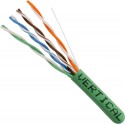Cat5e Bulk Unshielded (UTP) Ethernet Network Cable with Solid Copper Conductors - Riser CMR-Rated
Features:
✅ High-Performance Data Cable
✅ 350MHz Bandwidth for Data Applications
✅ Category-5E Unshielded Twisted Pair
✅ 24AWG Solid Copper Conductors
✅ Easily Identified Color-Striped Pairs
✅ Exceeds TIA/EIA-568C.2, ISO/IEC 11801
✅ Riser Rated PVC Jacket, CMR
✅ ETL Listed, RoHS2 Compliant, REACH Compliant, TAA Compliant
✅ CM/CMR rated for use in walls and conduit in ceiling
Cables4sure Ethernet Cable are made of 100% pure bare copper wire.
Description:
Cat5e solid copper UTP bulk cable is a type of Ethernet cable used for networking purposes. It is made up of solid copper wires that are twisted together in pairs and enclosed in a protective outer jacket. The "Cat5e" designation refers to its ability to transmit data at speeds up to 1 gigabit per second over a distance of up to 100 meters.
This type of cable is commonly used for wired internet connections, as well as for connecting devices within a local area network (LAN). The solid copper wires provide better signal quality and transmission than cables made with other materials like aluminum or copper-clad steel. The UTP (unshielded twisted pair) design helps to reduce electromagnetic interference, allowing for clearer and more reliable data transmission.
Overall, Cat5e solid copper UTP bulk cable is a popular choice for networking installations in homes, offices, and other commercial settings.
Specification:
Conductor Material: Solid Copper
Conductor Size: 24 AWG
Cable Type: UTP (Unshielded Twisted Pair)
Cable Rating: Cat5e
Data Transmission Speed: Up to 1 Gbps
Frequency Range: 1-350 MHz
Jacket Material: PVC (Polyvinyl Chloride)
Jacket Color: Various colors available
Cable Length: 1000 feet
Operating Temperature Range: -20°C to +75°C (-4°F to +167°F)
TIA/EIA Compliance: TIA/EIA-568-C.2
Cat5e Unshielded Bulk Cable vs Cat5e Shielded Bulk Cable:
Cat5e cables are available in two main types: UTP (unshielded twisted pair) and STP (shielded twisted pair).
UTP cables are the most commonly used type of Cat5e cable. They consist of four twisted pairs of wires that are not shielded by any additional material. UTP cables are generally easier to work with and less expensive than STP cables. They are suitable for most applications and are often used for home and small business networks.
STP cables, on the other hand, have a shield made of metallic material around each pair of twisted wires. The shielding helps to reduce electromagnetic interference from nearby electrical devices and other sources. This makes STP cables more resistant to noise and crosstalk, which can improve signal quality and reliability. However, STP cables can be more difficult to work with, as the shielding must be properly grounded.
The choice between UTP and STP Cat5e cables depends on several factors, including the specific application, the level of electromagnetic interference in the environment, and the distance between the devices being connected. For most home and small business networks, UTP cables are sufficient. However, in environments with high levels of electromagnetic interference or where long cable runs are necessary, STP cables may be a better choice.
Cat5e vs Cat6 Bulk Cable:
Cat5e and Cat6 are two types of Ethernet cables that are commonly used for networking purposes. While they have many similarities, there are also some key differences between them.
The main differences between Cat5e and Cat6 are:
Data Transmission Speed: Cat6 cables are designed to support higher data transmission speeds than Cat5e cables. Specifically, Cat6 cables are capable of transmitting data at speeds of up to 10 Gbps, while Cat5e cables are limited to speeds of up to 1 Gbps.
Frequency Range: Cat6 cables have a wider frequency range than Cat5e cables. Specifically, Cat6 cables have a frequency range of up to 500 MHz, while Cat5e cables are limited to a range of up to 350 MHz.
Construction: Cat6 cables typically have thicker wires and a tighter twist than Cat5e cables, which helps to reduce crosstalk and electromagnetic interference.
Cost: Cat6 cables are generally more expensive than Cat5e cables due to their higher performance and construction standards.
It's worth noting that while Cat6 cables are capable of higher data transmission speeds than Cat5e cables, the actual speed you'll achieve depends on a variety of factors, including the network equipment you're using and the distance between devices. In some cases, the difference in performance between Cat5e and Cat6 may not be noticeable, particularly for home and small business networks.
Copper Ethernet Cable vs CCA (Copper Clad Aluminum)
Cat5e copper cable and CCA (Copper Clad Aluminum) cable are two types of networking cables that are used for connecting computers, printers, and other devices in a Local Area Network (LAN). The main difference between them is the material used for the conductor, which is the central part of the cable that carries the electrical signal.
Cat5e copper cable has a solid conductor made of pure copper, while CCA cable has a conductor made of aluminum coated with a thin layer of copper. The use of CCA in place of copper in network cables is driven by the desire to reduce costs, as aluminum is less expensive than copper. However, this cost-saving measure can lead to a number of problems, including reduced performance and reliability.
Here are some of the key differences between Cat5e copper cable and CCA cable:
Conductivity: Copper is a better conductor of electricity than aluminum. CCA cable has a higher resistance than copper cable, which means that it can generate more heat and cause signal loss over long distances.
Flexibility: Copper cable is more flexible than CCA cable. This makes it easier to install and handle, especially in tight spaces or when making sharp turns.
Durability: Copper cable is more durable than CCA cable. It is less prone to breakage or damage due to repeated bending, stretching, or twisting.
Compatibility: Copper cable is compatible with all standard RJ-45 connectors and networking devices, while CCA cable may not be compatible with some devices due to its higher resistance.
Overall, Cat5e copper cable is the preferred choice for most networking applications, as it offers better performance, reliability, and compatibility than CCA cable.
Cables4sure has never and will never sell CCA cables!!!

Old reference (SKU#):
601000-BL - 1000FT CAT5E BULK CMR UTP COPPER CABLE BLUE
601000-BK - 1000FT CAT5E BULK CMR UTP COPPER CABLE BLACK
601000-GY - 1000FT CAT5E BULK CMR UTP COPPER CABLE GREY
601000-GN - 1000FT CAT5E BULK CMR UTP COPPER CABLE GREEN
601000-WH - 1000FT CAT5E BULK CMR UTP COPPER CABLE WHITE
601000-RD - 1000FT CAT5E BULK CMR UTP COPPER CABLE RED
601000-OR - 1000FT CAT5E BULK CMR UTP COPPER CABLE ORANGE
601000-YL - 1000FT CAT5E BULK CMR UTP COPPER CABLE YELLOW
601000-PR - 1000FT CAT5E BULK CMR UTP COPPER CABLE PURPLE


